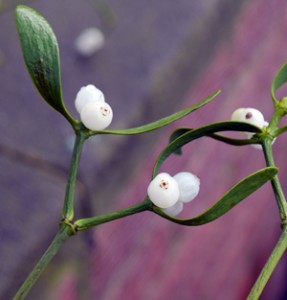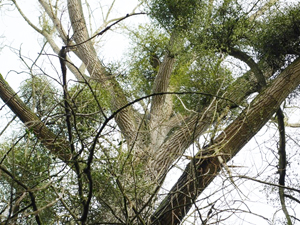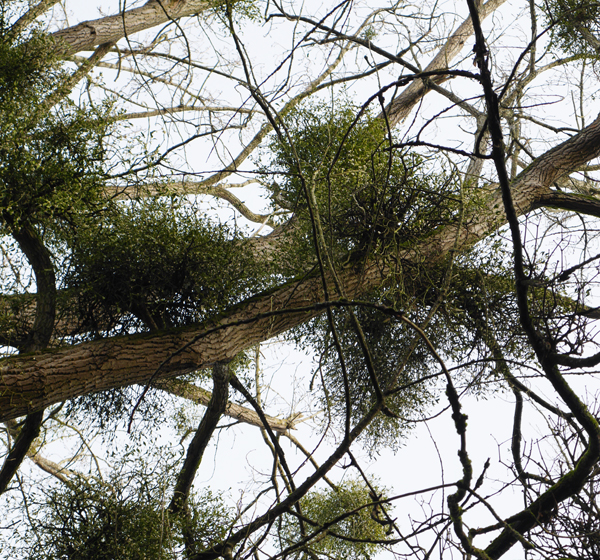Mistletoe

Three evergreen plants come to mind at this time of year - Holly, Ivy and Mistletoe. Holly and Ivy are 'immortalised' in "The Holly and the Ivy" , a traditional Christmas carol. Both holly and ivy have been part of church decoration since the fifteenth and sixteenth centuries (as recorded in churchwardens’ accounts). Mistletoe, (also known as “the golden bough” or Viscum album), is well known for its connection to Christmas, in particular for the custom of “kissing underneath the mistletoe”. Mistletoe associations go way back and there are many customs and myths surrounding the plant. For example, Druids greatly revered it, believing that it held the soul of the host tree. It would be cut from sacred oak trees with a golden sickle. It was used in folk / herbal medicine to treat a variety of ailments. Now, like many plants, mistletoe is being investigated for its phytochemicals and possible medical uses.
Mistletoe has evergreen, smooth-edged, oval leaves that are arranged in pairs along the stem. These can and do photosynthesise - fixing carbon dioxide into sugars and other carbohydrates. It is described as a partial parasite or hemiparasite. This is because it draws water and mineral salts from the host plant. It does this by forming haustoria - ‘clamp-like’ connections with the xylem tissue of the host plant. The xylem is the water conducting tissue of the plant; it also carries a number of important mineral ions.
- fixing carbon dioxide into sugars and other carbohydrates. It is described as a partial parasite or hemiparasite. This is because it draws water and mineral salts from the host plant. It does this by forming haustoria - ‘clamp-like’ connections with the xylem tissue of the host plant. The xylem is the water conducting tissue of the plant; it also carries a number of important mineral ions.
The white / opalescent berries (botanically known as drupes) that form in the winter months are often taken by birds, but the sticky, viscid tissue around the seeds make them difficult to swallow. So, a bird (for example, a blackcap or mistle thrush) will scrape off the seed from the beak onto the bark of a tree, where it may germinate.
 The sticky material (or Viscin) may also help stick the seed to a possible host. The sticky viscin contains a mixture of cellulosic strands (like the material that makes up plant cell walls) and mucopolysaccharides. The host range of the European Mistletoe encompasses some 200 different species, but common hosts in the U.K. are Apple, Lime, Hawthorn, Poplar, Maple, Willow, Crab Apple and False Acacia. The growth of the mistletoe can reduce the vigour and (the distal) growth of the branch on which it is growing, but with management the host tree is not significantly affected.
The sticky material (or Viscin) may also help stick the seed to a possible host. The sticky viscin contains a mixture of cellulosic strands (like the material that makes up plant cell walls) and mucopolysaccharides. The host range of the European Mistletoe encompasses some 200 different species, but common hosts in the U.K. are Apple, Lime, Hawthorn, Poplar, Maple, Willow, Crab Apple and False Acacia. The growth of the mistletoe can reduce the vigour and (the distal) growth of the branch on which it is growing, but with management the host tree is not significantly affected.
Though it grows on trees, woodland is not necessarily the most common habitat for mistletoe - gardens, orchards, church yards, park lands, roadsides and hedgerows offer many possibilities for the growth of mistletoe. More information on mistletoe and its cultivation can be found at mistletoe.co.uk, including where to buy it and also 'grow your own kits'.
Comments are closed for this post.


Thanks Chris for this interesting article.
Ashley
13 December, 2014